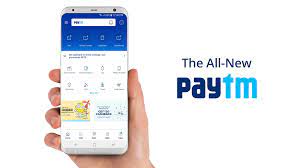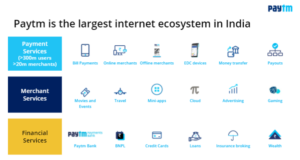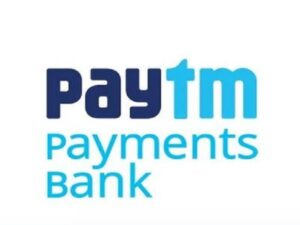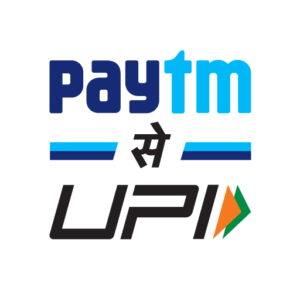One97 Communications, the parent company of Paytm, a digital payment platform, had a disappointing debut on the stock exchange after its share price plunged more than 26% from the issue price. Vijay Shekhar Sharma, the CEO, mentioned that the much-hyped IPO’s underperformance on the first day does not reflect the company’s weak long-term performance. Paytm’s IPO comes after stellar performances of other digital startups after listing, such as Nykaa, Policybazaar, and Zomato, whose public valuations were higher than private ones. He believes people do not understand the Paytm’s business model and other fintech companies compared to other consumer internet firms. For instance, with any food delivery app like Zomato- it is easy to understand customer acquisition, how they make money, etc.
The CEO believes that the market in the short run is opinion polls. On the other hand, in the long run, they act as weighing machines. Therefore, Paytm’s business model requires creating a huge ecosystem in the long term, and the stock market cannot impact the purpose of the company. The company lost over $3 billion in market cap after trading hours on the first day of listing. Currently, the market cap is around $5.24 billion. After the IPO, Alibaba and Ant Group have a 30% stake in the company, which could lead to regulatory clearance issues.
However, analysts believe overpricing and growth concerns are primary issues for the drop in share price.
The company has competitors in wealth management, payment gateway, insurance, etc. Google (Google Pay), PhonePe, and Facebook (UPI via WhatsApp) are giving them cut-throat competition. It is also betting on lending and insurance services. They want to leverage the existing user base of 300 million via cross-selling of such products.

About Paytm
Paytm’s initial service proposition was recharging business. Later, it diversified and advanced to produce new services such as Paytm Wallets, Insurance, UPI, Banking, Wealth Management, E-commerce, TV advertising, ticketing, etc. Hence, it is difficult to understand Paytm’s business model due to it different sources of revenue and customer base. It also provides stock broking services to its registered users. Moreover, it offers cashback to customers via Paytm Cricket League Cashback, where users collect playing cards and cashback up to ₹1,000 after reaching certain levels.
Paytm has approximately 300 million customers. It is a self-service app that has a 24*7 customer service centre.
Paytm came into existence after demonetization in India in 2016 as online payments became efficient and effective. It allowed the company to prosper and acquire a large customer base.
The RBI license to Paytm is the primary resource for the company. Moreover, it is an easy-to-use app which offers online and without internet transactions to reach out to all income levels. Further, Paytm Payment Bank charges banks and financial companies for issuing cards and making payments via mobile phones.
Paytm’s Business Model: How does Paytm earn money?
Most Indian customers using Paytm used the app for making payments via a wallet system, which made digital payments easier before UPI (Unified Payment Interface) came into existence. People believe that Paytm earns money from digital payments. However, 77% of revenue is from the payments and financial services. The company aims to focus on broader financial services. The company has expanded in areas such as e-commerce and financial services.
The Paytm app is a super app that offers various services to customers in categories such as payments, banking, insurance, wealth management, e-commerce, and others.

Payments
Payment is the flagship source of revenue for the company. Paytm, the largest payment platform in India, offers payment services to merchants and customers. Paytm’s overall market share in mobile payment transactions is 40%, whereas, in wallet payment transactions, it is 60%. The company offers options such as Paytm Wallet, Food Wallet, Bank Accounts, Fastag, BNPL (Buy Now Pay Later), and EMI (Equated Monthly Installment) for customers. Moreover, it also provides consumer UPI transactions but remains the third-largest player in the segment. UPI transactions happen via Paytm Payments Bank. For merchant ecosystem, they provide QR codes, PoS (Point of Sale) solutions, and sound boxes.
Paytm earns money via transactions fee and take-rates charges to merchants. It also charges convenience fees to customers. These are the primary sources of revenue. Moreover, they also have a subscription-based model for merchant services like soundbox and PoS machines.


Financial Services
The company offers mobile banking services like opening savings and current accounts, time deposits, etc., via Paytm Payments Bank. It also provides credit via Paytm Postpaid, a BPNL service. In addition, it disburses personal loans and post-paid products. According to Motilal Oswal’s reports, the lending vertical will increase sharply and become Paytm’s core revenue-earning segment in a couple of years.
Moreover, Paytm’s Insurance Broking is an insurance marketplace offering life, auto, and health insurance products. It also provides claim services and policy management.
Further, Paytm Insurtech is its insurance arm which offers general insurance. It has a customer base of 11.3 million. It also acquired a global reinsurance firm- Swiss Re and Raheja QBE General Insurance.
Paytm charges sourcing fees to financial institution partners and collection fees for loans and credit card distribution. Moreover, it charges a commission on insurance premiums and equity broking fees.

E-commerce and Cloud Business
Paytm also has its online shopping mall, Paytm Mall, where one can shop for the desired products. The company allows merchants to connect with the customers. It offers cloud services to enterprises, telecom, digital and fintech companies. It also provides ticketing and gaming services. Moreover, it provides Paytm First, a subscription-based model offering rewards and loyalty programs to Paytm users.
Additionally, Paytm is the second-largest ticket booking platform in India, according to the tickets sold. The ticketing service vertical contributes to approximately 20% of Paytm’s revenue.
Moreover, the company charges ticketing business transaction fees to merchants and convenience fees to customers. It also charges subscription fees to merchants and enterprises for offering cloud services.
Revenue Model of Paytm
| Payment Services | Transaction Fee charged to merchants based on the GMV. |
| Consumer Convenience Fees | |
| Subscription Fee from merchants for providing PoS and soundbox | |
| Financial Services | Revenue-based on the type of services offered |
| Sourcing Fee from financial institutions (deposits and account openings) | |
| Collection Fee from lending partners | |
| Upfront Distribution Fee per credit card and on the percentage of annual spend | |
| Equity Broking Fee | |
| Commission on insurance premiums | |
| Consumer Services | Transaction Fee on travel, ticketing, entertainment, advertising, etc., from merchants |
| Consumer Convenience Fees | |
| Cloud Services | Subscription and Charging Fees from merchants for offering cloud services and brand marketing |




